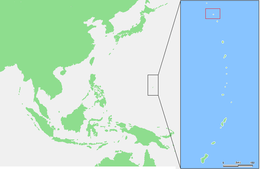Maug Islands

US Geological survey photo of Maug islands
|
|
 |
|
| Geography | |
|---|---|
| Location | Pacific Ocean |
| Coordinates | 20°2′N 145°13′E / 20.033°N 145.217°E |
| Archipelago | Northern Mariana Islands |
| Area | 2.13 km2 (0.82 sq mi) |
| Highest elevation | 227 m (745 ft) |
| Highest point | North Island |
| Administration | |
|
United States
|
|
| Commonwealth | Northern Mariana Islands |
| Demographics | |
| Population | - uninhabited - (2010) |
Maug (from the Chamorro name for the islands, Ma'ok, meaning "steadfast" or "everlasting") consists of a group of three small uninhabited islands. This island group is part of the Northern Islands Municipality of the Northern Mariana Islands chain in the Pacific Ocean.
The Maug Islands lie about 70 kilometers (43 mi) south of Farallon de Pajaros and 37 km (23 mi) north of Asuncion. The archipelago consists of three islands, the eroded exposed outer rim of a submerged volcano with a caldera with a diameter of approximately 2.2 km (1.4 mi). The floor of the caldera is around 225 meters (738 ft) below sea level, and in the middle is a mountain whose summit is only 22 m (72 ft) below sea level. The total area of the islands combined is 2.13 square kilometers (0.82 sq mi), and the highest point is 227 m (745 ft) above sea level.
The islands are overgrown with savannah grass. On East Island are Pandanus trees and Coconut Palms (Cocos nucifera), near the former settlement.
About 10 km (6.2 mi) northwest of the Maug Islands is Supply Reef, a submarine volcano whose summit is 8 m (26 ft) below sea level. The Maug Islands and the Supply Reef are part of the same volcanic massif, and are connected by a saddle about 1,800 feet (550 m) below sea level.
From a European perspective, the Maug Islands were discovered on 22 August 1522 by Gonzalo Gómez de Espinosa, who named it Las Monjas (The Nuns in Spanish). Gómez de Espinosa was a member of Ferdinand Magellan‘s attempted circumnavigation of the globe, and after Magellan’s death unsuccessfully attempted to navigate the ship Trinidad across the Pacific Ocean to Mexico. Gomez de Espinosa found the largest island of the Maug Islands settled by Chamorros, who called the island Mao or Pamo. Gómez de Espinosa freed the Chamorro whom he had kidnapped on Agrihan and three of his crewmen deserted the Trinidad on the island. Two of the deserters were killed by the Chamorro, but the third, Gonzalo Alvarez de Vigo, later came to Guam. In 1669, the Spanish missionary Diego Luis de San Vitores visited the Maug Islands and named it San Lorenzo (St. Lawrence). In 1695, all of the inhabitants were forcibly deported to Saipan, and three years later, to Guam. Since that time, the islands have been uninhabited.
...
Wikipedia
